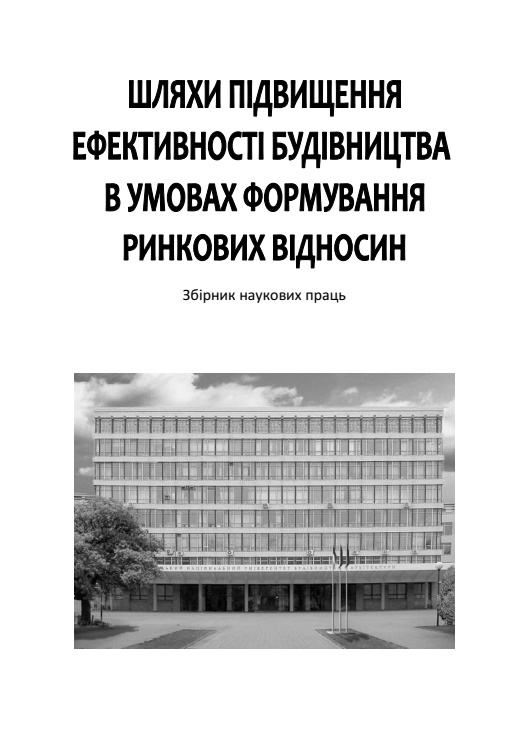Metapractical direction of optimization of production processes in construction industry
DOI:
https://doi.org/10.32347/2707-501x.2021.48(1).13-19Keywords:
construction, management, organization, system, production, optimization, section, level, harmony, opportunityAbstract
The scientific article reveals the problem of finding innovative approaches in solving the optimization problems of construction production. The perspective tendencies of harmonious possibilities in the optimization of production systems of construction are considered. The urgency of the issue of finding rational solutions in the multidimensional space of alternatives and the effective correlation of functional production subsystems in an environment of mutual influence has been substantiated. The main regularities of the work of metaeuristic optimization of the golden section, its ratio, levels, factors of influence are revealed. The considered scheme for finding the optimal solution based on the harmonious proportion of the geometric division of the segment. The ways of applying the principles of harmonious management in the management of building production systems in the direction of sustainable and logical development have been substantiated. The above study has shown that building production systems undergo an optimization platform in the process of their development and acquire a new progressive quality. When realizing its functions, fluctuations of the system determine the level of its organization, which corresponds to harmonious (sustainable) development. The use of the "golden proportion" in the management of construction production in combination with information technology contributes to the evolution and development of the structural diversity of production systems in a changing environment. The results of the study made it possible to reveal a harmonization approach in improving the interaction of the structural elements of production and accelerating their functional sensitivity to changes in the environment. A harmonious production system more effectively adapts to the multidirectional interests, goals and actions at all levels of management of various subsystems in any conditions. The prospect of the research leads to the scientific formation of algorithmic support for the processes of organizing and managing construction using metaeuristic methods, which will allow solving practical problems of optimal control of nonlinear dynamic production systems of construction.
References
Гилл Ф.,Мюррей У., Райт M. Практическая оптимизация. пер. с англ. Москва: Мир, 1985. 509 с.
Иванус А.И. Код да Винчи в бизнесе или гармоничный менеджмент по Фибоначчи. Москва: ЛЕНАНД, 2005. 104 с.
Iryna Arutiunian, Maryna Poltavets, Maryna Аchacha, Olena Bondar, Fedir Pavlov, Oleksandr Gerasymenko, Tetiana Kulinich. Effective Concepts of Harmonious Management of Production Systems. International Journal of Computer Science and Network Security. Vol. 21 No. 3. March 2021. pp. 141-144. URL: https://doi.org/10.22937/IJCSNS.2021.21.3.19
Павлов И.Д., Павлов Ф.И., Каплуновская М.А. Определение уровня гармоничного менеджмента в строительном производстве. Вісник Придніпровської державної академії будівництва та архітектури. Днепр: ПДАБА, 2009. №4. С. 43-50.
Пантелеев А.В., Скавинская Д.В., Алешина Е.А. Метаэвристические алгоритмы поиска оптимального программного управления. Москва: ИНФРА-М, 2016. 430 с.
Щербина А.О. Метаэвристические алгоритмы для задач комбинаторной оптимизации. Таврійський вісник інформатики та математики. №1 (24), 2014. С. 56-72.
Storn, R. & Price K. (1997). "Differential Evolution – A Simple and Efficient Heuristic for global Optimization over Continuous Spaces." Journal of Global Optimization 11(4): 341 -359.
Xin-She Yang. Metaheuristic Optimization. Scholarpedia, 6(8):11472. (2011), doi:10.4249/scholarpedia.11472
Downloads
Published
How to Cite
Issue
Section
License

This work is licensed under a Creative Commons Attribution 4.0 International License.
Authors who publish with this journal agree to the following terms:
- Authors retain copyright and grant the journal right of first publication with the work simultaneously licensed under a Creative Commons Attribution License that allows others to share the work with an acknowledgement of the work's authorship and initial publication in this journal.
- Authors are able to enter into separate, additional contractual arrangements for the non-exclusive distribution of the journal's published version of the work (e.g., post it to an institutional repository or publish it in a book), with an acknowledgement of its initial publication in this journal.
- Authors are permitted and encouraged to post their work online (e.g., in institutional repositories or on their website) prior to and during the submission process, as it can lead to productive exchanges, as well as earlier and greater citation of published work (See The Effect of Open Access).

